
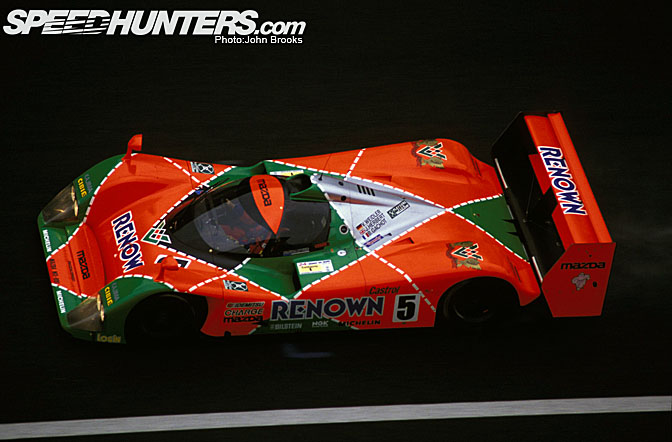
The problem with getting to the top of Mount Everest is once you get back down to sea level where do you go next? Some would say it is the price you pay for ascending the heights, like Icarus getting too close to the Sun, others of us lurking in the shadows would say be grateful for ever reaching the summit.
Of course the mark of a great champion is to repeat the feat and keep repeating it, however that becomes almost impossible if the rules get changed 180 degrees………..and that brings us to the situation that faced MazdaSpeed after their fantastic outright victory at the 1991 edition of Les Vingt Quatre Heures du Mans. The 787B's Rotary had barely cooled down when three days after celebrating victory at La Sarthe, FISA (the sport's governing body) announced that only cars with 3.5 litre atmospheric engine would be allowed to race in the 1992 Sportscar World Championship, not only that but rotary engines were outlawed. Well what now? Well if Mazda wanted to defend their title at Le Mans they would have to comply as the great race was part of the SWC and FISA mandated that all entries had to attend all rounds and not cherry pick.
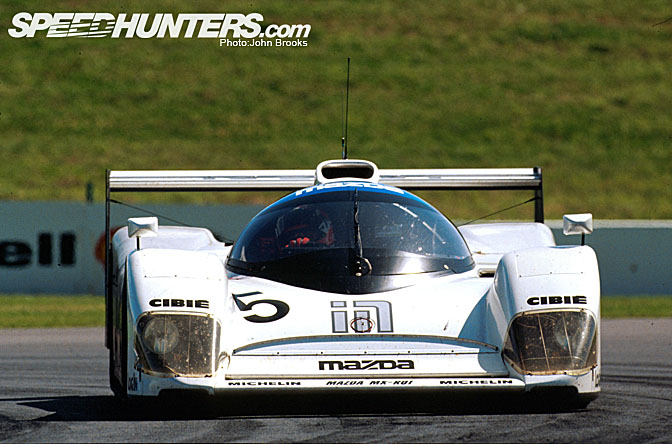
FISA at that time was led by an eccentric and mercurial Frenchman, Jean-Marie Ballestre, who as President appeared to many insiders to be a front man for the Dos Amigoes who really controlled what was going on, Max Mosely and Bernie Ecclestone. Bernie has always been a shrewd operator and is almost solely responsible for the development of Formula One into a global sport. First he organised the teams, then the circuits and races, then the television coverage. In order to take the enterprise to the next level he saw that the involvement of car manufacturers, who are notorious spendthrifts, would be key. So like any business man he set about capturing the manufacturers who were not involved in Grand Prix, in reality this meant those running in Sportscar World Championship, ie. Jaguar, Mercedes-Benz, Porsche, Aston Martin, Peugeot, Nissan, Toyota and Mazda. Bernie parachuted in a trusted lieutenant, John McDonald, to take control of the administration and shake up the Championship and prepare it for some changes or perhaps decimation.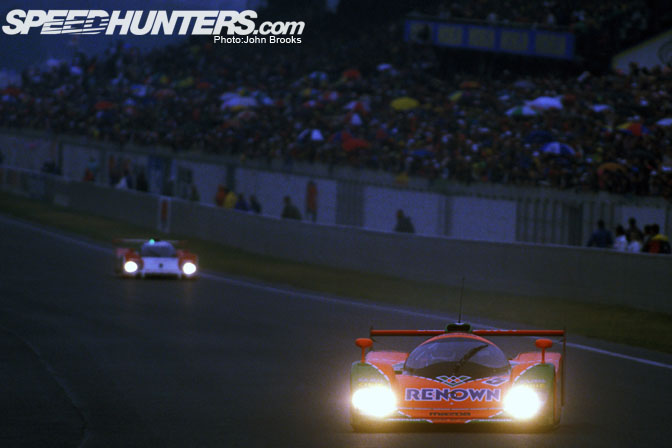
Next, prompted by Bernie, some said, the FISA President announced in 1990 that the fuel efficiency formula of the SWC that been running since 1983 would change. 1991 would be a transitional year and 1992 the change would be total. The rules for the engines would broadly match those in existance for Grand Prix racing, so should anything happen to the SWC the manufacturers and their investment in 3.5 litre technology would have a ready made home. Of course this would be the optimum result for the Man in charge.
The success of the old rules package known as Group C was largely as a result of the availabilty of a turn key competitive car at a reasonable cost, the Porsche 956 and its successor the 962. Wherever endurance races were held there were usually 10 to 15 of these cars in attendance and right up 1991 they were more than capable of taking outright wins in the right hands. The other thing about the Porsches was that they were user friendly, so those whose financial attributes exceeded their driving skills could climb aboard and generally not disgrace themselves. The new 3.5 litre cars were a very different prospect, not only did you have a top professional to exploit the staggering downforce levels, you also had to be built like a jockey, just as with single seaters. John Nielsen, along with Price Cobb and Martin Brundle, won Le Mans for Jaguar in 1990. So there was no doubting his skill levels and yet he could not fit into the new cars, they could not close the door on him, so he was dropped from the programme. Of course the cars were way more complicated, so cost more and required more crew to work on them, the budgets spiralled out of the reach of the privateer teams. As if this was not enough FISA started to bring all manner of expenses into play. I remember working for a sponsor, Hydro Aluminium, who used the SWC to create business to business opportunities and also to motivate staff who could attend the races. They would bring in significant numbers, I recall there being over 1,500 guests at Monza. Overnight the cost of this hospitality trebled and faced with this daylight robbery they and other sponsors departed, leaving the fields thinner and poorer…..this was just an example of the costs that were heaped on the competitors, usually giving little tangible benefit…..and folks wondered why I was cynical?
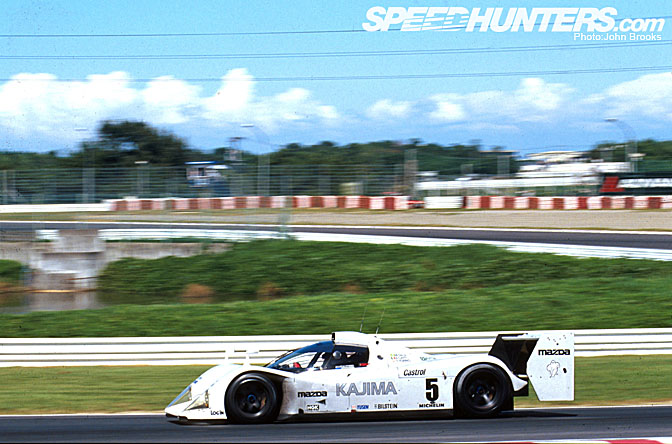
There had also been a great deal of politics involved with the French leader of FISA and the very French Automobile Club de l'Ouest (organisers of the Le Mans 24 Hours) fighting a bitter campaign for control of this part of the sport and the great race that was at that time part of the SWC. In November 1989 FISA decreed that to ensure safety for spectators and competitors that no circuit would get FIA approval if it had a straight over two kilometers in length. The Ligne Droite des Hunaudieres, better known as the Mulsanne Straight, was arguably the most famous feature of the 24 hours circuit, consisting of six kilometers of the RN138 road connecting Le Mans with Tours, and to comply with this rule would have to incorporate two chicanes. Oh and by the way this has to be done by January 1st of the following year.
Changes to a public highway are not the matter of moment's work, especially in a country with a bureaucracy like France. To be fair there had been a number of accidents when contemporary tyre development was pushed to and over the limit by the combination of high downforce and very high speeds – the Sauber Mercedes team were regularly exceeding 400kph/250mph in the 1989 race. Anything going wrong at that speed would be catastrophic.
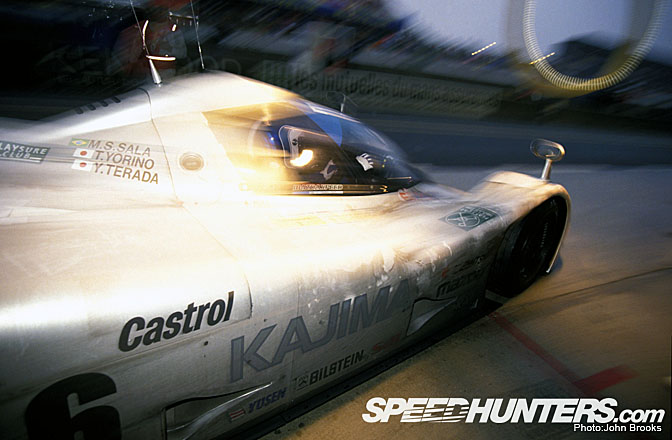
Mazda may have been Le Mans Champions but they lacked the huge financial resources available to Toyota, Mercedes and Peugeot, more over to get a car ready for the 1992 European season would be impossible in the time scales. So the optimum solution financially and logistically was to purchase a chassis and engine package and work from there. The final race of 1991 at the remote Autopolis circuit saw Toyota bring a new car, the TS010 to the grid. This and the brief feeling of optimism that there might be up to five manufacturers in the hunt for 1992 plus a few privateer projects gave the MazdaSpeed management enough encouragement to take up an entry in the SWC.
The new car was to be built by TWR (Tom Walkinshaw Racing) and based on their SWC title winning Jaguar XJR-14. This was to be modified by Mazdaspeed's designer Nigel Stroud in particular to accomodate the new engine. The MX-R01 was to powered by a Judd V10 developed for Formula One. The 72 degree V10 was as supplied by Judd but most of the internals (crankshaft, con rods, pistons and valves) were updated by MazdaSpeed.
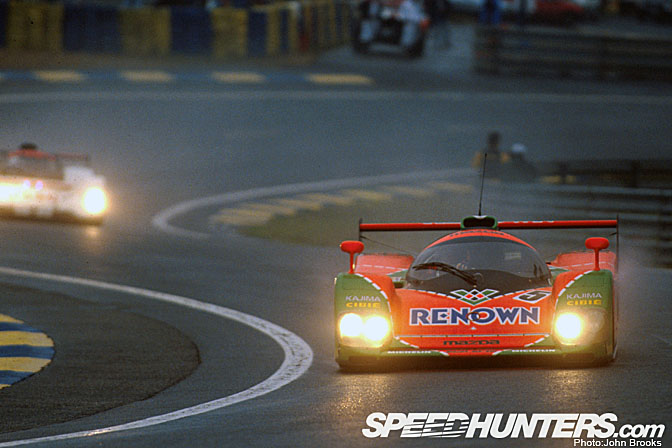
The plan was to run one car in the first part of the season and then from Le Mans increase this to two entries. Drivers would be the heroes of 1991, Herbert, Weidler and Gachot (now out of custody) plus Mauricio Sandro Sala, Yojiro Terada and Takashi Yorino. So much for the good news.
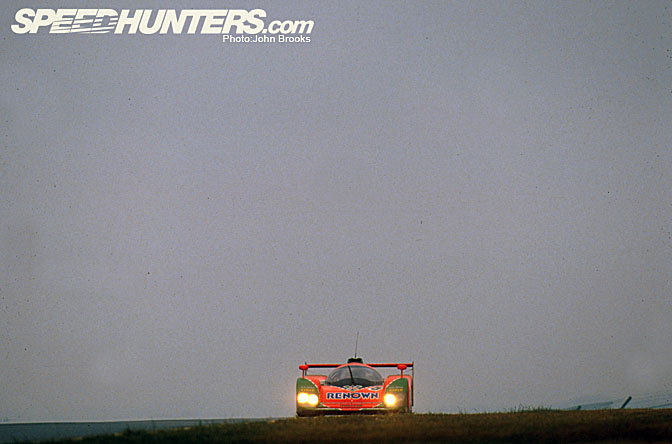
Soon after the Mazda management team had given the green light the whole ediface of sportscar racing began to collapse. Mercedes Benz announced their withdrawal from competition, no doubt prompted by a lucky win at Autopolis after suffering multiple engine failures during 1991 – it was said at the time that all 30 flat-12 engines had a fatal flaw. Jaguar and Silk Cut also left the grid and a plan to run five TWR cars with backing from the Sultan of Dubai was exposed as a mirage, complete fantasy. As was another plan to run four Allards and four Spices. Max(now elected FISA President) and Bernie seized their chance and cancelled the 1992 Championship. After much arm twisting (by Jean Todt and Peugeot) it was restored but the delays and confusion had destroyed any credibility left. Mazda were appalled at the conduct of all the parties concerned but decided to honour their commitment.
This was a turbulent time financially, especially in Japan with the property and stock market bubble bursting and world events like the First Gulf War and the collapse of the Soviet Union adding to the feeling of unrest. For the manufacturer from Hiroshima the 1992 SWC was a major endeavour, so to be treated in such a cavalier fashion was doubly disgraceful.
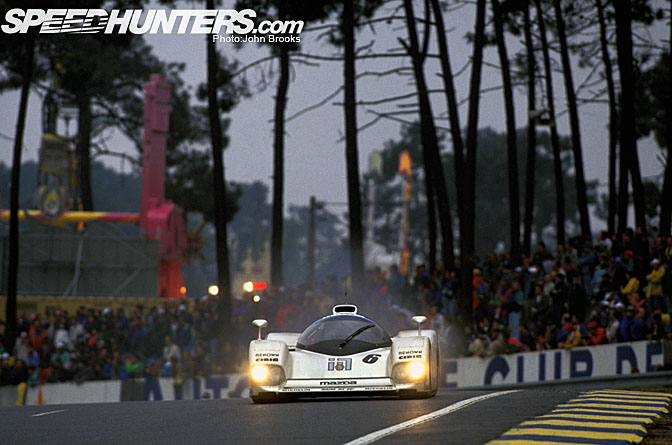
After all the dust settled there was even some racing. The first round scheduled to be at Autopolis in Japan was canned, so proceedings kicked off at Monza. The Mazda MX-R01 was not really ready to take to the track and during practice and qualifying suffered a number of problems such as engine mounting bolts shearing off, a water leak and then a blown engine. The Mazda's race only lasted 35 laps with some sort of electrical failure. The race turned into a farce with only one car finishing, the Toyota TS010 of Geoff Lees and Hitoshi Ogawa. They inherited the lead two laps from the finish when Yannick Dalmas put his Peugeot 905 on its roof at the Parabolica. 11 cars started, three finished but two failed to complete enough laps to be classified. It was going to be a long season.
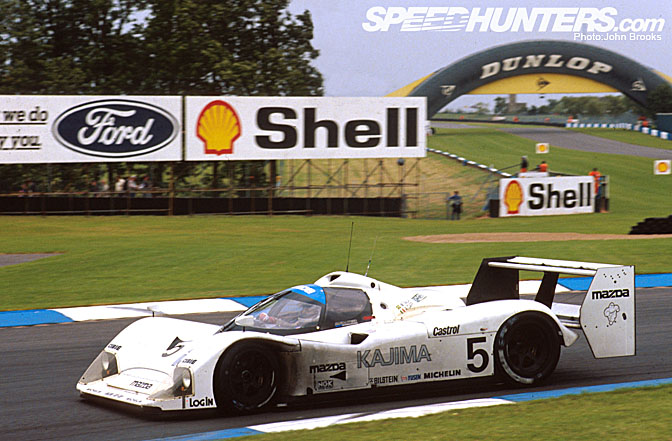
The next round of the SWC was at Silverstone and glory be, another entry, the BRM P351, although they did not make it to the grid as the engine expired during the warm up. MazdaSpeed's fortunes picked up with a strong second place for Johnny Herbert and "Maurice" Sala in the MX-R01. They lacked the ultimate pace of either the Toyota or the Peugeot but the hard work at the factory and back in Japan was beginning to show.
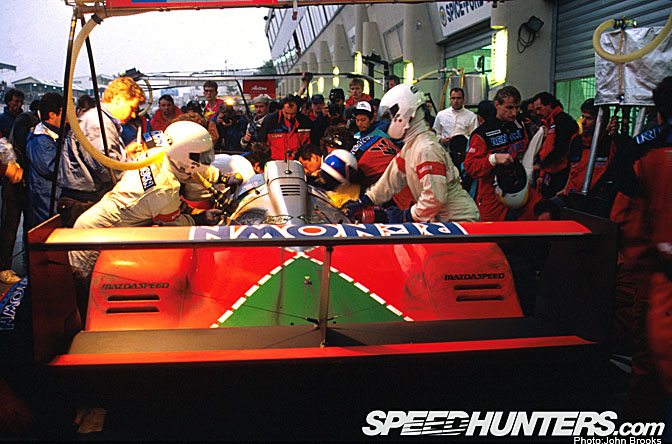
Next up was the big race of the year, Le Mans.
The question on everyone's mind was would any of the 3.5 litre cars make it to the finish or even to sundown? The entry, as always the case in 1992, was anaemic with just 24 cars conforming to the SWC rules and four other national formula cars which were widely regarded as total s**tboxes. They should never have been allowed to take part being around 60mph off the pace of the leaders down the Mulsanne, a crazy speed differential while running in the daylight, never mind about the dark.
Toyota and Peugeot had completed a huge amount of miles testing, the French completing six full scale trials and felt confident of getting a result. MazdaSpeed was less sanguine about their prospects. Extensive modifications to the engine back in Japan and 10,800 rpm limit meant that there was confidence about the durability of the powerplant but much less so about that quality of the transmission. Hugues de Chaunac, boss of ORECA, who were running things at La Sarthe had the team rehearse changing the transmission on the day before the race.
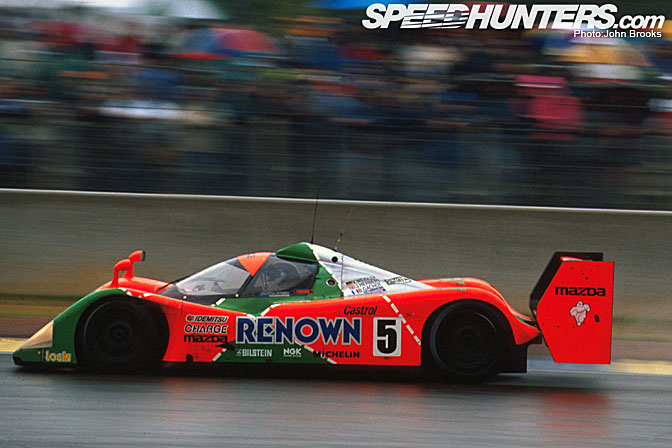
The two cars were set up to different specifications, with #5 in standard sprint format and the #6 in a low drag setup with the top tier of the rear wing removed. These two shots should illustrate the difference clearly.
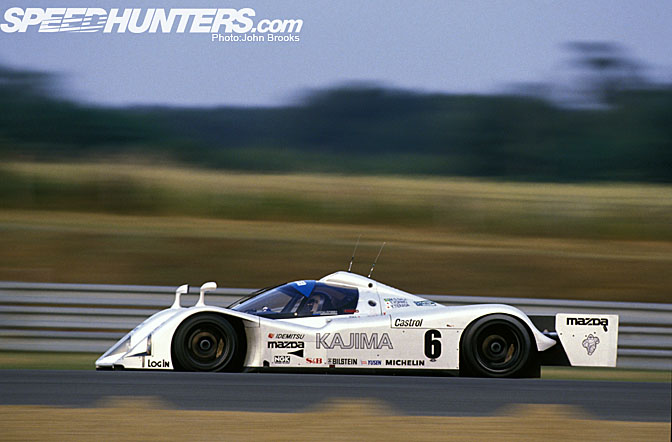
The conservative approach that the team used in the run up to the race meant that Herbert/Weidler/Gachot started in 7th recording 3:34.329 and their team mates were 10th some 4 seconds slower. It was more like a November afternoon than June as the race was flagged away in cold, gray and wet conditions. Peugeots took their expected 1-2 position at the head of the small grid on the opening laps but there was one car really on the move, Weidler in the MX-R01. The Charge car was on a charge and by lap six had snatched the lead from the Peugeots. The French were not amused and made suggestions that the German slow to a more reasonable pace (ie behind the 905s) but the conditions suited the handling of the MX-R01 and its Michelin tyres. Ok, it was not going to last as the Peugeots and Toyotas would assert themselves as the conditions got better but an accident between Ferte's Peugeot and Lees' Toyota brought the Mazda back up to third, still on the lead lap some five hours into the race. A few hours passed but a minor glitch with the lights and a replacement for a misting screen put the red and green car two laps down on the Peugeots.
The #6 car had taken a strategy of playing a waiting game, but around 1.00am Terada acquaplaned off at Maison Blanche wrecking the car and giving himself a mild concussion.
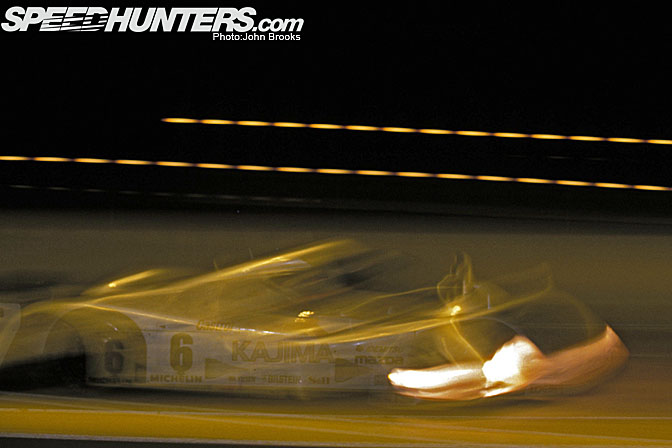
On and on through the night the #5 Mazda chased the leading Peugeots and as the half way point was reached it was hanging on just three laps down. Another three hours till dawn and then the first big problem hit Mazda when the gear linkage malfunctioned and it took three laps' time to replace and cost a lost position to the lead Toyota. And that is where the red and green car finished some 16 laps off the winning Peugeot of Dalmas/Warwick/Blundell.
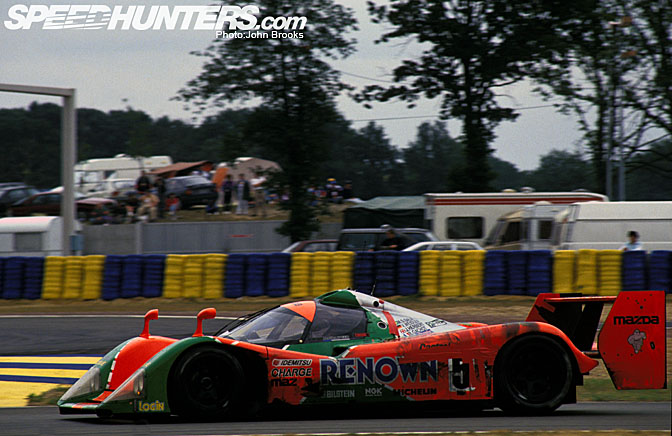
Fourth overall, completing 336 laps was an excellent result, considering the relative resources available compared to Peugeot and Toyota. The fact that the MX-R01 had led the race and pushed the Peugeots pretty hard would be a source of great satisfaction to Takayoshi Ohashi and Hugues de Chaunac and all the MazdaSpeed and ORECA team.
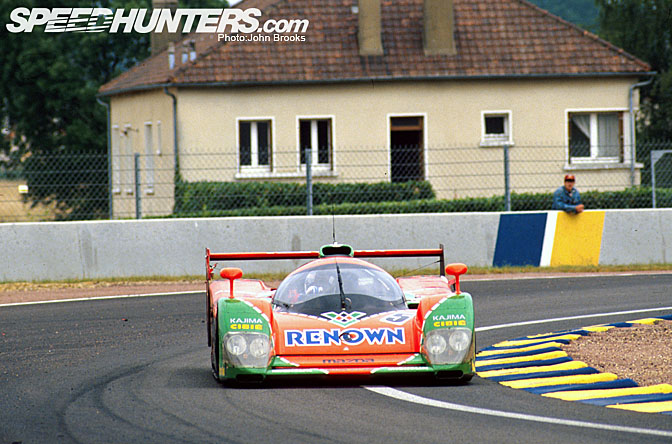
From the high water mark of the Le Mans 24 Hours it was back to reality at the next race which was round the Donington Park circuit. Ten cars on the grid made for desperately thin racing, Peugeot dominated and Mazda were strangely off the pace all weekend finishing only down in 5th place.
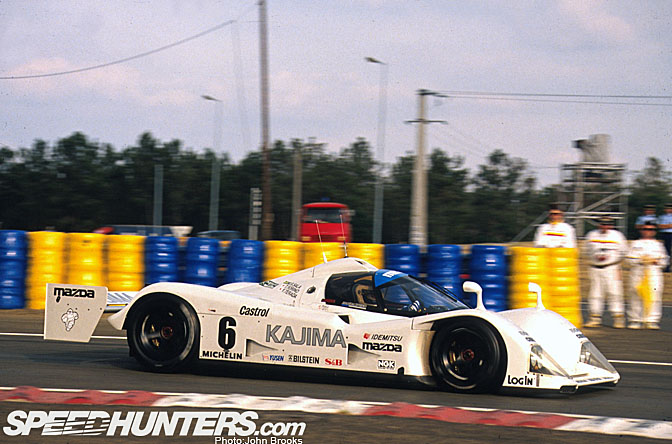
The next stop was the home race and the Suzuka 1000 kilometers and that represented a low point for MazdaSpeed's 1992 campaign when the transmisson expired just past the half way point in a cloud of smoke.
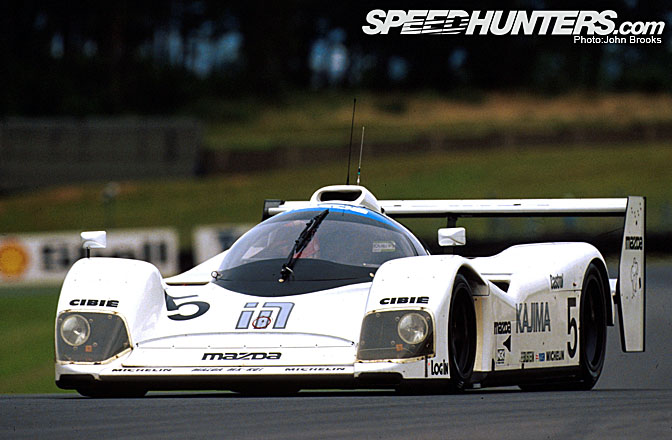
The final indignity was the last SWC round held at Magny Cours. There was a crowd, as Peugoet bussed in most of their workforce from all over France but they only got to see 8 cars. Mazda like everyone else had lost interest in this charade. Two weeks before the race there had been a few lines in a FISA Bulletin "Due to the extremely small number of manufacturers interested in entering, the 1993 Sportscar World Championship has been cancelled." So it was official this was the end of the road. Forty years of competition was finished.
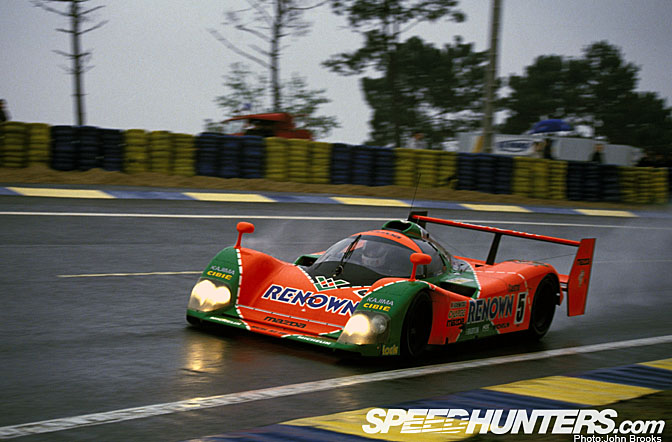
The destruction of the Endurance Championship was an act of sporting vandalism that was breathtaking in its cyncism, but if you consider the perpetrators and their records it is not a surprise. The aim, which was to get manufacturers into Formula One, worked to an extent, with Mercedes Benz, Toyota, Peugeot and Jaguar all taking that route though only the Germans have enjoyed any real or lasting success. Mazda was a casualty, having been honourable even in the face of duplicitous behaviour, it could walk away from the sport with dignity intact.
The MX-R01 project was ill timed but the form showed at Le Mans gave a true indication of what would have been possible given better circumstances. Mazda should take pride in their sportscar heritage, it stands comparison with any in the sport.
John Brooks








Thanks for this insight John
throughout mazdas history, the company has shown that the size of the wallet is only one factor in producing results in the sportscar world. from the amazing showing with the cosmo L10s in the 1968 de la route to the win in '91. mazda has always been willing to be pushed around and has always proven itself as worldclass. every time mazda has taken the rotary to competition, it has ruled supreme. from the fantastic run in imsa-gtu in the 80s' to today with the rx-8s in the gt ranks.
great job mazda. a true sports car company.
Damn good story John, your writing and photographs put together really capture those moments, swear to god I caught a whiff of burnt rubber after reading the last word =). Keep up the good work!
Excellent story John, perhaps the best Ive read on Speedhunters. I absolutely agree with your comments re the charlatans at the helm of FISA at the time. Ive been of the opinion for some time that Bernie is well qualified for retirement and I only need to think of the fact that Mosely didnt step down from the FIA last year to break ito a violent fit of Tourettes. Although who could replace him is a bit of a question...
Great story John, a really good read and an insight into how Bernie is quite ruthless in destroying those championships that might take manufacturers away from F1.
Amazing article! and the photos really give an air of nostalgia to the story. It's really a great shame that any of this was allowed to just happen, but i suppose there was nothing to be done; politics will always be the bane of motorsport.
.
One can only wonder how far Mazda could have taken the Wankel in top-class motorsport, no doubt they would have been a formidable opponent for the 1992 season if they had not outlawed its use.
That was an excellent, excellent story. I always love reading about the endurance cars of the 80's and early 90's. Anyone who liked this story should check out two books that I'm reading now, one of which is on the Sauber C9 and the other on the TWR SilkCut Jaguars. Excellent photographs too, John. Well done!
It's all in the details................. Three days running around the grounds of Goodwood House
I want the one with the really low wing.